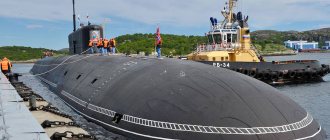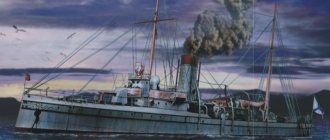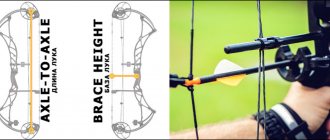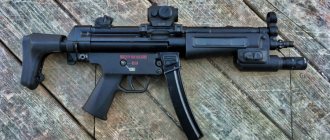The laying down of the two newest Project 22350 guided missile frigates at the shipbuilding plant will take place before the end of 2020. The Federal News Agency reminds readers of the difficult history of the creation of these ships.
Federal News Agency / Andrey Soyustov
Age of Sail
These classes originated during the times of sailing fleets. There were many types of sailing ships, but in the case of the military they were clearly divided into two main categories: the actual “ships” - three-masted ships with straight sails - and everything else.
Main types of sailing ships. The classification depended on the number of masts and the combination of straight and oblique sails
Within the ship category itself, the boundaries were more blurred, but to a first approximation they looked like this:
The largest ships with several - from two to four - gun decks. Their main purpose was artillery combat with their own kind as part of the “battle line”. Hence their name in most European languages - battleships.
Construction of battleships from a painting by I.K. Aivazovsky. Three gun decks for the flagship and two for the others
The lighter ones were considered frigates, although this name did not become official everywhere. Their main feature was only one closed gun deck. Frigates were ideal for independent operations: security, reconnaissance, cruising war on enemy communications. And they were also placed in the battle line for their sweet souls.
Russian 52-gun frigate “Pallada” from a painting by A.P. Bogolyubov. The only gun deck is clearly visible
The smallest of the ships - with guns only on the upper deck - were most often called sloops. Only in the 19th century did their French name, corvette, become more or less generally accepted. They also had many talents: patrol service, communications, coastal protection and the like, and they could also pinch enemy “merchants”.
Danish 20-gun corvette “Nayaden” from a painting by K.V. Eckersberg. The gun ports are in the bulwarks
Frigates appeared in the Russian fleet under Peter I, corvettes - at the end of the same 18th century. So it’s at least too late to suffer about groveling before the West now. This looks especially funny against the background of what proportion of our naval terminology consists of other “enemy” words.
History of project 20386
The new corvette, which received the heroic name “Daring”, is a prototype of the ship of the future. During the creation of the ship, the designers took into account the mistakes and errors made during the implementation of the previous project 20380. The creators decided to aim for something more and make a fundamentally new ship, something between a patrol ship and a frigate. The new creation of the Almaz Design Bureau was classified as a corvette, but in reality it is more reminiscent of a destroyer - a more powerful and larger ship.
Project 20386. Scheme
In accordance with the technical specifications, the Project 20386 corvette must successfully confront the enemy at the near and far approaches to the sea borders of our country. The combat functions assigned to the new vessels are impressive. We can say that the designers were given the task of incorporating into one project the capabilities inherent in ships of different classes, namely:
- protection of maritime communications within a 200-mile economic zone;
- countering potential enemy ships at any distance from the fleet's bases;
- ensuring stable air defense of ship formations against air attacks;
- search, detection and destruction of submarines in a given area;
- providing air defense and fire support for landing operations.
Having such a wide range of combat missions, the new ship must be significantly different from its predecessors and have special qualities. It was necessary to create a warship with striking power and at the same time capable of performing patrol and military-police functions. Time will tell whether this decision will be correct. For a patrol ship and a floating launch platform, the new corvette is too big. In addition, there is a question about the construction period of a series of similar ships and the total cost of the project.
The Russian Navy maintains a tendency to create different types of ships capable of solving similar combat missions. The most unpleasant thing is that all new projects are limited to small series. This does not make it possible to equip the fleet with modern combat vessels in the required quantities in a timely manner.
For example, in the US Navy, the famous Oliver Perry class destroyers were built in the amount of 71 units. The Chinese are not far behind the Americans, having managed to build almost two dozen corvettes of type 056 in 10 years. In total, the Chinese plan to build 60-80 ships of this class for the needs of their own navy.
Despite all the vicissitudes surrounding the new Russian corvette, the Ministry of Defense of the Russian Federation signed a contract for development work back in April 2014.
Age of steam
Frigates with corvettes survived during the “interregnum” period, when the ships had sails and steam engines side by side. But at the beginning of the 20th century, military fleets completely switched to mechanical propulsion, and by that time the role of frigates and corvettes had already been taken over by a new class, named after the main function of these ships - cruisers.
The classification of the “transition period” was very peculiar. For example, this Russian sailing and steam ship “Rynda” built in 1886 was officially called “an armored cruiser of corvette rank”
Part of the tasks of the corvettes fell on another new class - destroyers that grew out of “destroyers”, light high-speed ships that combined torpedo, artillery, and then also anti-submarine weapons. And the frigates and corvettes themselves disappeared from the scene for a long time.
Return
In the spring of 1939, England suddenly began to think: how would they protect communications from German submarines if something happened? You won’t have enough destroyers for this job, even taking into account the “escort” destroyers and sloops. So we decided to also produce small anti-submarine patrol boats based on the whaler project. Cheap and cheerful.
Why this little thing was called a corvette is a mystery.
The most popular of them were the 925-ton Flower-class corvettes with minimal armament. Instead of an expensive turbine, they had a steam engine that provided 16 knots of speed. This was enough to escort transports, but chasing submarines was already problematic.
Flower-class corvette and River-class frigate in the same scale
The seaworthiness of the “flowers” also left much to be desired, and in 1941 the British began building larger patrol ships - 1,400-ton River-class ships with a doubled range. They were already equipped with two steam engines - which raised the speed to 20 knots - and more serious weapons. At first, they were simply called “twin-screw corvettes,” but were then reclassified as—you guessed it—frigates.
Project 20386 weapons
New Russian corvettes will be significantly reinforced with stationary types of naval weapons. Assessing the design characteristics of corvette 20386, we can now say that the ship has become an order of magnitude more powerful than similar vessels being built for foreign fleets.
In the bow of corvette 20386 there is a package installation of the Redut anti-aircraft missile system. Next to it on the upper deck there is a powerful automatic 100 mm installation, and its turret is also made using Stealth technology.
Project 20386 corvette cutaway
Hidden in the main superstructure are the launchers of the ship’s main armament – the Uran anti-ship missile system. On the top of the superstructure, two AK-306 gun mounts are installed on both sides, providing close cover of the ship. In the internal hangars of the hull there are two launchers of the Paket-NK anti-submarine complex. With such a set of weapons, the new Russian corvette is capable of effectively solving a variety of combat missions. It can act either independently as a patrol officer or as part of a formation of ships.
The corvette is also equipped with reconnaissance and rescue equipment. At the stern there is a hangar and a landing pad for a helicopter. In addition, the ship is expected to have unmanned aerial vehicles. The latest electronic warfare systems will significantly enhance the ship's combat capabilities. Domestic developments in this direction make it possible to create effective means of suppressing the navigation equipment of foreign ships. In terms of the quality of technical equipment, the introduction of new technologies into the design of the ship and the use of innovative techniques, Russian combat ships can be compared with the new American and British ships of the Zumwalt and Daring type.
However, such a comparison does not seem entirely incorrect. The cost of building one American or British destroyer is incommensurate with the cost of building a Russian ship, since foreign projects require truly colossal allocations. And the tactical and technical characteristics of foreign ships are strikingly different from the parameters possessed by domestic corvettes of Project 20386.
American and British ships of the Zumwalt and Daring type.
The final version of the armament of Project 20386 corvettes has not yet been approved. In particular, the idea of equipping warships with Caliber cruise missiles cannot be discounted.
Modernity
Now frigates are called ships of the distant sea and ocean zone, smaller than destroyers. In addition to the traditional escort functions - anti-submarine and air defense of the formation - modern frigates are also capable of independent actions against surface and coastal targets. So in many fleets they actually occupied the niche of destroyers of previous generations.
A modest German lead frigate of the Baden-Württemberg class. Some unfortunate 7200 tons of displacement
Corvettes include everything between a boat and a frigate and is intended for operations in the near zone. And in the same way, there is a tendency to make them not highly specialized, but multi-purpose, combining both escort and strike capabilities.
Destroyers
In naval terminology, a destroyer is a fast, maneuverable, rugged warship designed to escort large vessels in a fleet, convoy, or battle group and protect them from powerful short-range attacks. They were originally developed in the late 19th century by Fernando Villaamil for the Spanish Navy as protection against torpedo boats, and by the time of the Russo-Japanese War in 1904 these "torpedo boat destroyers" (TBDs) were "large, fast and powerfully armed torpedo boats designed to destroy other torpedo boats." The term TBD was further shortened to simply "destroyer" by almost all navies by the First World War.
Destroyers are much smaller than battleships but larger than frigates, typically having a single gun (5 inches compared to the 16 inches on the Iowa-class battleships) and many missiles, including anti-ship, anti-ship, and cruise missiles ("Tomahawks" in the American case). Modern destroyers often also have a helipad, which helps in anti-submarine warfare.
The destroyer was originally a BNK class to provide cover for battleships and cruisers with their powerful but slow-firing guns from the high-speed and maneuverable torpedo boats introduced into service around the late 1800s.
Our frigates and corvettes
Recently, “official” frigates and corvettes have also appeared in the Russian Navy. Some considered this a banal monkey business, “a transition to NATO classification.” However, this view does not stand up to criticism, since no one will reclassify the existing patrol, anti-submarine, small missile ships, etc.
Lead frigate of Project 22350 “Admiral of the Fleet of the Soviet Union Gorshkov”
In our country, only newly built ships of the Admiral Grigorovich (project 11356R) and Admiral Gorshkov (project 22350) types are called frigates. And corvettes - ships of the Steregushchiy type and their development (projects 20380, 20385 and 20386). Moreover, our sworn “partners” also classify them as frigates.
Fragment of the laying board of the Project 20380 “Gromky” corvette (photo: V. Khanov, ASZ)
Unfortunately, the current “Guide to the Classification of Ships and Vessels of the Navy” is traditionally classified. So one can only assume that our fleet has introduced a new class of “multipurpose ship” (as opposed to the previous “specialized”), divided into two subclasses - “frigate” and “corvette”.
The notorious “spiral of history” has made another turn and returned to its origins. As it should be - at a new level.
Russian Navy. A sad look into the future. Frigates
In the article we bring to your attention, we will consider the state and prospects for the development of this, in general, new class of ships for our sailors, the frigate.
Due to the fact that frigates were not listed in the USSR Navy, the assignment of Soviet-built ships to this class is entirely on the conscience of the author. Of all the ships that were laid down in the USSR and were in the Russian Navy as of December 1, 2015, theoretically, frigates could include Project 11540 patrol ships, the last “singing frigate” of Project 61 “Smart”, and also, maybe patrol ships of projects 1135 and 1135M “Ladny” and “Pytlivy”. However, we have already discussed the Smetlivy in the article devoted to destroyers, and we talked about the Project 1135 SKR in the corvettes section. Accordingly, the only things left are:
SKR project 11540 – 2 units.
Standard displacement - 3,590 tons, speed - 30 knots, armament: 4*8 launchers for the Kinzhal air defense missile system, 2*4 launchers for the anti-ship missile system "Uran" (not on the Neustrashimy), 2*3 launchers for the anti-aircraft missile system "Vodopad-NK", 1 RBU-6000, 1*1 100-mm AU AK-100, 2 ZRAK “Kortik”, hangar for the 1st Ka-27 helicopter.
In total, three such ships were laid down: Neustrashimy, Yaroslav the Mudry and Tuman, but the latter was not put into operation, and in 2016 a decision was made to dispose of the unfinished hull. The only difference between Neustrashimy and Yaroslav the Wise, as far as the author knows, was the absence of Uran anti-ship missile launchers on the former (the author, alas, does not know whether there is control equipment for these missiles).
As a matter of fact, if there were ships in the Soviet fleet that could be called frigates, this is Project 11540. The fact is that the project was initially created as a “response” to numerous frigates of Western countries - the performance characteristics of all modern frigates at that time were analyzed, the best of them was selected (it turned out to be the German frigate “Bremen”) and then the Zelenodolsk Design Bureau received the task of designing “such same, only better” - and that’s how project 11540 turned out. By the way, to classify project 11540, the 1st Institute of the Navy proposed introducing a new “frigate” class into the official “Table of Ranks” of the Russian fleet, but S.G. Gorshkov considered this unnecessary.
Probably, the commander-in-chief was right after all, because to a certain extent, Neustrashimy seemed to continue the line of development of the TFR project 1135, but still with a greater emphasis on versatility. Without a doubt, air defense built on the “Daggers”, one 100-mm artillery gun and two “Kortik” air defense systems is much stronger than the “Osa” air defense system and a pair of 76-mm gun mounts. In addition, the ships of Project 11540 were provided with strike weapons in the form of eight Uran anti-ship missiles, which Project 1135 did not have at all (the ability of the Rastrub-B to shoot at ships is still a palliative). In addition, the ships of the Neustrashimy type now have what Project 1135 lacked - a hangar and a helipad.
The price for the helicopter and versatility was an increase in displacement by 755 tons and a known weakening of anti-submarine weapons. On the one hand, due to the installation of a more modern and powerful GAK MGK-365 Zvezda-M1 (and a helicopter), the search capabilities of the Neustrashimy were significantly improved, but at the same time, instead of four PLURs, eight torpedo tubes and two bomb launchers, the ship received six PLURs " Vodopad-NK" and one bomb launcher.
This replacement does not seem equivalent. Firstly, the absence of 533-mm torpedoes deprives the ship of a very powerful anti-submarine weapon precisely at those ranges at which its main gun is capable of detecting enemy submarines. Of course, instead of part of the PLUR, Neustrashimy can use torpedoes, but even in this case, the total ammunition of PLUR and torpedoes has been halved, which, in general, is not very encouraging. And secondly, the author of this article has encountered opinions that Vodopad-NK has one very significant drawback in comparison with other PLUR launch systems.
The fact is that the same “Rastrub-B” works like this - after launch, the PLUR flies “on a rocket,” that is, from the moment it leaves the launcher until it “arrives” at the location of the enemy submarine, the PLUR is in the air. At the same time, the Vodopada-NK PLUR is thrown into the sea like a torpedo, the rocket engines start when the PLUR is in the water, the ammunition “emerges” and then follows the target like the Rastrub PLUR. It seems like there’s a difference, but the nuance is that, unlike the “dry” launch of the Rastrub, the “wet” launch of the Vodopad-NK PLUR produces a lot of noise and the submarine’s main gun is clearly audible. Thus, the crew of a nearby submarine (and the range of the Vodopad-NK PLUR is up to 50 km) understood that it was under attack and could begin retaliatory actions (maneuvering, launching decoys, etc.). The author cannot say how fair such a claim is against Vodopad-NK (he is not a professional), but such an opinion exists.
But in general, the concept of Project 11540 ships looks very successful - if, of course, we consider them as a means of naval warfare in the near sea zone. Moderate displacement (and price) allow large-scale construction. Good anti-submarine warfare capabilities make ships of this type a very useful tool for ensuring the combat stability of our SSBNs in their deployment areas - in cooperation with anti-submarine aircraft and MAPLs and diesel-electric submarines, of course. Air defense is unable to repel a massive raid by modern aviation - well, even missile cruisers are powerless against such raids. But these ships are quite capable of protecting themselves from an attack by one or two planes, helicopters or cruise missiles, which allows them to be used in areas where massive raids are not expected, but an air threat still exists. The strike capabilities of Project 11540 ships are not amazing, but eight Uraniums represent quite an ultimate argument in a “dispute” with corvettes or missile boats, and assigning the task of fighting aircraft carrier groups to ships of such a small displacement is simply pointless. The Project 11540 ships turned out to be very successful, and one can only regret that only the Neustrashimy and Yaroslav the Wise were added to our fleet.
Thus, as of December 1, 2015, we had two ships of the frigate class, laid down during the Soviet era - all other ships of this class were put on the stocks in the Russian Federation.
Project 11356 frigates – 3 units
Standard displacement - 3,620 tons, speed - 30 knots, armament: UKSK "Caliber-NK" for 8 missiles, air defense missile system "Shtil-1" launcher for 24 missiles, 2*2 533-mm torpedo tubes, RBU-6000, 1* 1 100mm A-190 artillery mount, 2*6 30mm AK-630.
These ships are a direct continuation of the line of very successful domestic TFR Project 1135, developed by the Northern Design Bureau (Northern PKB), or more precisely, its modification 1135.1 “Nereus”. It was like this - the KGB of the USSR wanted to get a patrol boat to protect the maritime borders of the Soviet Union, and the choice fell on the Project 1135 TFR. As a result of the modernization, the PLUR launcher was removed, and a 100-mm artillery system was placed in its place. The rear 76mm cannons were also removed, replaced by a hangar and helipad.
Subsequently, the Northern Design Bureau used the Nereus as the basis for designing a frigate capable of operating in the ocean. This frigate was initially intended to be exported, India liked it, and as a result, the fleet of our strategic partner was replenished with six Talwar-class frigates.
And this is where the mysteries begin. It seems that the Talvar-class frigates have received quite decent capabilities in terms of searching for enemy submarines - the under-the-wing sonar APSOH and the towed SSN-137. Why “seemingly”? According to some reports, the towed sonar was not installed on these ships, there is only space for placing the SSN-137. And if the “other data” is still true, then, taking into account the rather average, as of today, capabilities of the underwater sonar APSOH, the anti-submarine capabilities of the Talvars are very small. As the main armament, the Talwars carry a launcher for 8 Club (Caliber) missiles, but it is unknown whether customers purchased missile-torpedoes for them, or whether the Indians are focusing exclusively on the strike version.
In general, there is a feeling that in the Talvars there has been a shift from an anti-submarine ship to an attack frigate with strong air defense, which is provided by one Shtil-1 beam complex and two Kashtan air defense systems, which are an export version of the Kortik air defense system. In combination with 8 “Calibers” or “Brahmos”, the Indians got a very formidable fighter.
But - for India, because its main enemy at sea is Pakistan, whose largest surface ships - frigates of types 21 and 22P are inferior to the Talwars in terms of their overall combat qualities. At the same time, the relatively weak anti-submarine weapons of Indian ships (not the best sonar and 2 * 2 torpedo tubes with an ammunition load of 16 very ancient SET-65E torpedoes and an RBU-6000 bomb launcher) are to some extent compensated by the fact that the basis of Pakistan’s submarine fleet is Diesel-electric submarines of the rather middle-aged French project "Agosta". Although here everything is unclear - the Indian frigates will serve for many decades, and Pakistan itself was going to acquire much more advanced German submarines of the 212A type... The situation with confrontation with the Chinese fleet is somewhat more complicated, but in general the Talwars are quite capable compared to the Chinese destroyers and frigates, but China has not yet acquired powerful attack carrier-based aircraft capable of effectively destroying surface ships of any class, and it is not known when it will succeed.
At the same time, the capabilities of the Talvars for the tasks of the Russian Navy cannot be considered sufficient. The extremely important anti-submarine function has been cut off, and the strike capabilities and air defense do not allow one to count on success in the confrontation with the AUG of the “sworn friends.”
The construction of these ships for the Russian Navy was not intended, but then, when it became clear that the rate of replenishment of the fleet with Project 20380 corvettes and Project 22350 frigates was extremely far from expected, it was decided to build a series of six such ships to replenish the Baltic and Black Sea fleets - 3 ships each to each. But then it was decided that all six ships of this project would go to the Black Sea Fleet.
Of course, it was not very good to simultaneously build frigates of two different types for our fleet (together with Project 22350 ships), but still the advantages of this decision clearly outweighed the disadvantages - the proven technology for constructing the Talvars seemed to guarantee their timely entry into service. It must be said that we could not simply reproduce the “Talwars” for the Russian Navy - the export Indian frigates were partially equipped with foreign equipment, which we had to replace with domestic equipment, so the “Indian” project was subject to modification in any case. And we finally have the opportunity to create a ship capable of not only maintaining, but even increasing the glory of its “ancestor” - the SKR project 1135. Unlike the Indians, who received a series of universal ships focused primarily on strike functionality and air defense , we needed a universal frigate, whose main feature was to be anti-submarine warfare. Alas... it didn't work out. By and large, Project 11356 is a development of the 90s of the last century, and today is not at the forefront of scientific and technological progress. Well, it was all the more important to pay close attention to the ship’s weapons and equipment, improving it if possible and thereby increasing the combat capabilities of the domestic frigate. Instead, the economy of “fewer numbers, cheaper prices” seems to have prevailed.
As a result, domestic ships of the “admiral series” (all frigates of Project 11356 received the names of admirals of the Russian fleet) received, it seems, the weakest sonar of all modern surface ships of the Russian Federation (who has it, of course) - MGK-335M-03, which in its own way Even the “Talvarov” APSOH sonar was inferior in capabilities, and they did not receive a towed sonar at all. With such equipment, even the possibility of countering German-built Turkish boats (type 209) looks somewhat doubtful, let alone looking for the latest nuclear-powered American and non-nuclear European submarines in the Mediterranean Sea...
There is an opinion that the UKSK for the Caliber missiles of Project 11356 frigates cannot use missile-torpedoes, but this is most likely wrong. But the “admirals” really seem to be unable to use Onyxes, therefore, there is a question about promising hypersonic missiles. The Admiral Series can most likely carry the Kalibr family of PLURs, but is there much sense in this in the presence of such a weak sonar? The main problem of the “ancestor” of the “admirals”, Project 1135, is the presence of a “long arm” in the form of “Rasstrub-B”, in the absence of a “watchful eye”, i.e. somewhat of a “long-range” sonar system. And now, after so many years, we are reproducing this problem to almost the same extent on domestic frigates of Project 11356.
The installation of an outdated SAC could be understood if something more modern were missing, but by 2010 we already had new complexes of the Zarya-2 and Zarya-3 types, installed on Project 20380 corvettes and 22350 frigates, respectively, and representing the next generation of hydroacoustic stations. Or were they afraid that Zarya had not yet been brought to condition (if they had not been brought to condition at that time)? But who prevented the installation of at least a towed Vignette? The only thing that somewhat smooths out this situation is the presence of a helicopter, but in general the anti-submarine capabilities of Project 11356 frigates are obviously disappointing.
Air defense. Not everything is simple here either. On the one hand, many naval enthusiasts breathed a sigh of relief when they saw a vertical launch system instead of the obsolete single-boom anti-aircraft missile launcher. But the ammunition load remained the same - 24 missiles, so the gain was only in the speed of their launch (which, without a doubt, is very important). Moreover, instead of the ZRAK “Dirk”, or at least the ZAK “Broadsword”, which one would expect, the frigate received only a pair of AK-630M “metal cutters”. And this is also completely incomprehensible.
On the one hand, yes, indeed, the Kortik anti-aircraft missile and artillery complex was criticized for the fact that it often “did not have time” to finish shooting from machine guns what was not shot down by anti-aircraft guided missiles, so the prevailing opinion was that the combination of the AK-630 and The Kinzhal air defense system is better than the Dirk air defense system. But the frigates of Project 11356 do not have the Kinzhal! The basis of the ship's air defense is the Shtil-1 medium-range air defense system, but these are still slightly different complexes and their tasks are also different. In principle, the Kortik air defense system (and on later ships, if you dream, Pantsir-M) would very organically complement the Shtil-1 air defense system in terms of its capabilities. Therefore, the placement of our regular AK-630M instead of ZRAK, from the author’s point of view, can only be explained by petty savings.
In general, despite all of the above, the Project 11356 frigates turned out to be quite good ships and, of course, became a long-awaited addition to the Russian Navy. But it’s a shame that due to completely inappropriate, “three-penny” savings on weapons and equipment, they do not fully reveal their potential.
As is known, three ships of this type were accepted into the Russian Navy: “Admiral Grigorovich”, “Admiral Essen” and “Admiral Makarov”, and the remaining three did not have time to receive turbines produced in Ukraine before the coup d’etat, and now they won't receive it. To this day, the fate of these three ships remains unclear. Nevertheless, the bmpd blog reported in June 2022 that a decision had been made to complete the construction of Project 11356 frigates with domestic gas turbine units. It must be said that the new power plant has its pros and cons.
The fact is that the original project assumed the use of two M7N1 gas turbine units with a power of 30,450 hp. every. The M7N1 unit consisted of two gas turbine units (GTU) - one with a power of 8,450 hp. for economic speed and the second, “afterburner”, with a power of 22,000 hp. for full speed. Thus, on two “economic” turbines, the frigate developed a power of 16,900 hp, and the total power was 60,900 hp.
Now, according to the bmpd blog, they plan to install two gas turbine units on the ships, each of which consists of two M70FRU gas turbine units with the same power of 14,000 hp. Thus, the economic progress will be carried out with a turbine power of 28,000 hp ., and full speed - at 56,000 hp. What can you say about this? The maximum speed of the frigates will not “sag” much, but the economic speed will increase - however, without a doubt, the cruising range with Russian gas turbines will decrease - the greater power of two M70FRUs will lead to increased fuel consumption. Be that as it may, the completion of the second trio of frigates 11356 for the Russian Navy can only be welcomed. One can only hope that since the three unfinished ships of this project will still be redesigned, there will be room on them for both the Pantsir-M and the latest hydroacoustic systems, although, of course, this is crazy optimism. A long break in construction, new engines and the adaptation of ships to them obviously lead to an increase in the cost of building frigates, and in this regard, one should expect not additional costs for improving weapons, but all-round savings.
Project 22350 frigates – 0 units.
Displacement - 4,500 tons, speed - 30 knots, armament - 2 * 8 UVP for missiles of the "Caliber" / "Oniks" family, 4 * 8 UVP "Redut" air defense systems, 2 * 4 324-mm torpedo tubes "Paket-NK" , 1*1 130-mm AU A-192M, 2 ZAK "Broadsword".
The history of the creation of frigates of this project has been described many times and there is no point in repeating it again. We only note that Project 22350 was for some time considered by the fleet command as the main ship of the ocean zone, designed to replace destroyers and large anti-submarine ships of the USSR fleet. The fallacy of such a concept stemmed from the hope of getting a cheap universal ocean-going ship in the dimensions of a frigate, which, alas, is impossible.
In the early 2000s, the Northern Design Bureau created Project 21956, which is a destroyer with a total displacement of about 9,000 tons (the standard displacement is not reported, but by analogy with the same “Admiral Chabanenko” it can be assumed that it was at the level of 7,500 tons). The ship was to be armed with 16 anti-ship missiles or other missiles of the "Caliber" family and 48 launching Fort-M air defense systems, as well as eight 533-mm torpedo tubes (with the ability to launch "Caliber-PLE" anti-ship missiles), a single- or double-barrel 130 -mm gun mount, two ZRAK “Dirk” and a hangar for two helicopters.
Of course, it was impossible to cram such weapons into a “frigate” standard displacement of 4,500 tons; sacrifices had to be made. Despite the use of the much lighter and more compact Redut air defense system, the number of launchers was reduced to 32. Formally, the Project 22350 frigate carries the same strike weapons, 16 launchers for the Caliber/Onyx family of missiles, but in practice this is not the case, because the frigate had to abandon 533-mm torpedo tubes in favor of 324-mm “Package-NK”.
It must be said that the Package-NK is a very serious weapon system, but still its torpedoes are primarily anti-torpedo ammunition. It can also be used to destroy a submarine, but against it it is a “last chance” weapon, i.e. in case an enemy submarine is suddenly discovered a few kilometers from the ship. Despite all the advantages of the Package-NK ammunition, their range and speed are, of course, completely incomparable with “full-fledged” 533-mm torpedoes.
As a result, in order to be able to effectively operate against enemy submarines, the Project 22350 frigate will have to occupy part of its 16 mines with missile and torpedoes, but the Project 21956 destroyer? Having “large-caliber” torpedoes, it remained a formidable enemy for the submarine even without it.
But perhaps the most important advantage of the Project 21956 destroyer over the Project 22350 frigate is its seaworthiness and cruising range - at 18.5 knots of economic speed, the destroyer is able to travel almost 1.5 times more than a frigate at 14 knots. In terms of these capabilities, the Project 21956 destroyer is quite comparable to the American Arleigh Burkes. This means, for example, that the destroyer 21956 is capable of accompanying a moving AUG - a nuclear aircraft carrier, of course, can break away from our destroyer, but then it needs to abandon its guard. But the Project 22350 frigate is incapable of this. In addition, in peacetime, the policy of the Russian Federation requires ensuring the presence of its warships for the purpose of displaying the flag in various areas of the world's oceans, and a destroyer (due to its large size and autonomy) is, of course, better suited for this than a frigate. And this is not to mention the fact that the Project 21956 destroyer was equipped with a gas-turbine power plant without the use of diesel engines, which are very capricious from domestic manufacturers.
Nevertheless, and with all of the above, Project 22350 frigates would be a welcome addition, because the fleet today is in desperate need of ships of all classes. Unfortunately, the lead “Admiral of the Fleet of the Soviet Union Gorshkov”, laid down on February 1, 2006, after 12 (!) years of construction is still not in service. It is well known that it had long ago become part of the Russian Navy, if not for the problems with the Poliment-Redut system (which is a symbiosis of the Poliment radar and the Redut air defense system).
As you know, the Redut air defense system is a “spoilt” version of the S-350 Vityaz, a medium-range anti-aircraft missile system that uses, among other things, missiles with an active homing head. Both of these complexes should have been delivered to the army and navy a long time ago; the same “Vityaz” was expected back in 2012, but alas... It seemed that in the second half of 2022, “the light at the end of the tunnel” did appear: according to the general designer of the concern Aerospace Defense, Pavel Sozinov's Almaz-Antey, state tests of the S-350 Vityaz were finally supposed to be completed in 2022. And in 2022 they were already going to “promote” it for export.
Alas, 2022 is already behind us, and the S-350 has not completed state tests. It is clear that its naval version, “Redut”, is even more complex, therefore... On February 3, 2022, USC President Alexey Rakhmanov told reporters, verbatim, the following:
“The commission that looked into the reasons for the unsuccessful launches has completed its work. All the main technical improvements that need to be made have been identified, but further colleagues need time, I believe it could be a couple of months - until, probably, mid-to-late March, in order to carry out the necessary test firings. After which, I believe, the next round of government testing will be scheduled.”
Also, the USC president expressed hope that the “Admiral of the Fleet of the Soviet Union Gorshkov” will enter service before the end of summer 2022. Alas, there are certain doubts about this, and this is not only about the Redut air defense system or the Poliment radar. According to the highly respected resource flotprom.ru, the Kolomna diesel engines installed on the Gorshkov “distinguished themselves” - one of them broke down on December 23, 2022, work to repair it is carried out directly in the engine room. Separate parts of the engine are sent to Kolomna for inspection and repair, and, if necessary, replacement. The crankshaft parts will also be sent to the factory. According to sources, it won’t be necessary to completely “remove” the diesel engine from the ship by cutting through the side, but... okay, let’s hope for the best.
Of course, sooner or later the Admiral of the Fleet of the Soviet Union Gorshkov will still enter service - not in 2018, but in 2022, but with subsequent ships in the series the situation is more complicated - due to Ukraine’s refusal to supply us with gas turbine units, we were left without new ships. For some reason, in a country in which there is a lot of talk about creating high-tech industries, and which was going to build dozens of corvettes and frigates, no one bothered to create high-quality diesel engines and its own gas turbine production. The fleet has learned the “wisdom” of this decision in full - now work on creating its own gas turbines is in full swing, but still their production in the coming years will be very limited.
According to the GPV 2011-2020, the fleet should have included 6 frigates of Project 11356 and 8 frigates of Project 22350; in fact, as of 2018, we have only 3 frigates of Project 11356 in service. With the highest degree of probability, the remaining 3 ships of the “admiral” series will be included in construction during the GPV 2018-2025. As for the “Gorshkovs”, on May 4, 2016 S.K. Shoigu said that by 2025 the fleet should receive 6 such ships, but, apparently, plans have changed again. The fact is that today there are four ships of this type in various stages of construction and completion - in fact, the Gorshkov itself, and three more frigates laid down in 2009, 2012 and 2013, respectively. No more ships of this type were laid down, and there are no rumors about their imminent start of construction.
But information appeared about a certain “Super-Gorshkov”, or frigate of Project 22305M. It seems that the leadership of the country and the fleet has abandoned attempts to “compact the impossible” into a minimum displacement, and the only thing that is known about the new project is that it will be significantly larger than the frigates currently under construction. The total displacement of the Gorshkovs is indicated at 5,400 tons, while the same figure for the 22350M project should be... and this is where the intrigue begins. According to the first data about the 22350M project, its total displacement will be 1.1 thousand tons more than that of the Gorshkov and will be 6,500 tons. Subsequently, information appeared that the total displacement of the new ship will be from 6,500 to 8,000 tons And in the summer of 2022, Deputy Commander-in-Chief of the Russian Navy for Armaments, Vice Admiral Viktor Bursuk, during the International Naval Show in St. Petersburg, said that the displacement of the 22350M frigate will be “about 8,000 tons.” Thus, we see that the 22350M project is gradually developing towards growth to the size of a full-fledged destroyer.
There is a photograph circulating online that (possibly!) shows the layout of the “Super-Gorshkov”.
Judging by the proportions, this ship is comparable in size to the Project 21956 destroyer, which we discussed above. A moment of glory - that a ship like the destroyer of Project 21956 is much better suited to our fleet than the small frigates of Project 22350, we wrote in detail in August 2016 in the article “Shipbuilding Program of the Russian Navy, or a Very Bad Premonition (Part 3)” and the author I’m very glad that the Russian Ministry of Defense ultimately came to the same conclusions.
Nevertheless, the situation for the next ten to fifteen years remains extremely depressing. Because as of December 1, 2015, we had 19 destroyers and 2 Soviet-built frigates, including: Project 1155 and 1155.1 BODs - 9 units; Project 956 destroyers – 8 units; BOD project 1134B – 1 unit; SKR project 01090 (formerly BOD project 61) – 1 unit; SKR project 11540 – 2 units.
And in total - 21 ships, of which by 2030, at best, there will remain 7 BODs of Project 1155, Admiral Chabanenko of Project 1155.1 and 2 TFRs of Project 11540, which we described at the beginning of the article. At the same time, until 2025 and taking into account those delivered in 2016-2018. ships, in the best case, we will get 6 frigates of Project 11356 and 4 frigates of Project 22350. It seems not so bad - if you just forget that the frigates of the “admiral” series are absolutely no match for a destroyer or anti-submarine ship, but are just descendants of patrol ships ships of Project 1135, that is, these are ships of a lower class than Soviet BODs and destroyers, and they cannot be considered as a full-fledged replacement. And if we forget about the unreliable Kolomna diesel engines of Project 22350 frigates...
What about the newest Project 22350M frigates? Generally speaking, they will have to become the ships that can replace today's BODs and destroyers, but... To date, none of these ships have been contracted, i.e. there are no contracts for their construction. Worse, even the 22350M project as such, in general, does not exist. And to make it completely clear at what stage the work on project 22350M is now, let us quote the press service of the United Shipbuilding Corporation dated July 3, 2022. In their words:
“preliminary study of the appearance of the Project 22350M frigate. The Ministry of Defense has not yet approved the appearance of the ship, from which it follows that individual characteristics, including displacement and also the composition of the power plant, have not yet been determined."
That is, in fact, as of the middle of last year, not only a project, but even a technical specification for the project had not been formed. And when all this will happen, and when the first frigates (essentially destroyers) of Project 22350M will go on the slipways is completely unknown.











